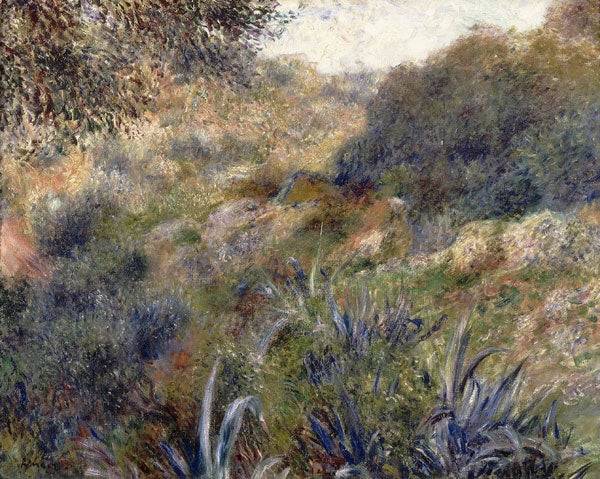Algerian Landscape: The Ravine Of The Wild Woman 1881 (65 x 81 cm) Pierre-Auguste Renoir
Musée d’Orsay, Paris

There is much to dislike about Renoir. His far too many nudes, often reclining on gorgeous banquettes like so many giant chickens ripe for the plucking, are often too sugary to touch us very deeply. His effects can seem too sweetly calculated. And when he painted landscapes (which he did much less often), he often seemed to incline too readily towards the calculatedly picturesque. In short, he could recognise a typical, comfortably acceptable Renoir when he saw one.
This is not one of those paintings. Renoir's trip to Algiers represented a kind of time-between-times. He took the trip to this French colony (as it was then) in north Africa in 1881, and he was the only Impressionist to do so. He made a second trip the following year - but not for too long. Just a quick toe-dip was quite sufficient. The other Impressionists were even less ready to engage with orientalist themes. For a number of them, la France profonde was quite profonde enough. What Renoir found there proved to be quite extraordinary. What a range of thirst-slaking, flaming colours! Yes, this new landscape fell upon him, took him aback, by its unruliness, its wildness, its unkemptness. And, as a consequence, he was capable of seizing it uncalculatingly - rather as D H Lawrence did in Sea and Sardinia.
What then do we have here? We have a ravine in the countryside outside Algiers, bursting with shrubs, flowers, trees, weeds, grasses. It's a gloriously colourful and untamed wilderness. The title suggests that a spicy anecdote is in tow somewhere, but we get no hint of that from this painting. We cannot really tell how great a distance Renoir is taking in with his eye - it seems both close to us, fairly immediate, and also to stretch quite hazily far away, and we experience both these impressions almost simultaneously. It is as if his eye is gulping it down, the nowness, the sheer, ravishing visual abundance of it all, the sprawling, up-and-down-and-across energy of the scene. It looks a little like hair, which is being combed by unruly winds in all directions at once, surging back and forth, forever unstable. No sooner does our eye begin to move in a certain direction than it hits an obstacle and doubles back on itself. Our visual ride across the painting's surface is that of a roller coaster, turbulent, bumpy, altogether exhilarating, more proto-Fauvist than Impressionist.
At one moment there is so much roughness - look at those threateningly spiky aloes in the foreground, for example - and then, ah, so much smoothness too, though not for long. Nothing happens for long in this painting. We see too how many, many individual brush strokes the painting consists of. Interestingly, this is not being done, we feel, in order to capture an effect of light - this is not theory-driven in any way, not especially impressionistic. It is because Renoir's eye registered so many damned leaves; they seemed to be coming at him in such quick, heart-stopping abundance.
ABOUT THE ARTIST
Pierre-Auguste Renoir (1841-1919) was one of the founding fathers of Impressionism. At his best, he was capable of capturing the immediacy of nature; at his worst, he painted to do nothing but please, and occasionally he failed to do even that. He possessed, in short, an unerring gift for superficiality.
Join our commenting forum
Join thought-provoking conversations, follow other Independent readers and see their replies
Comments